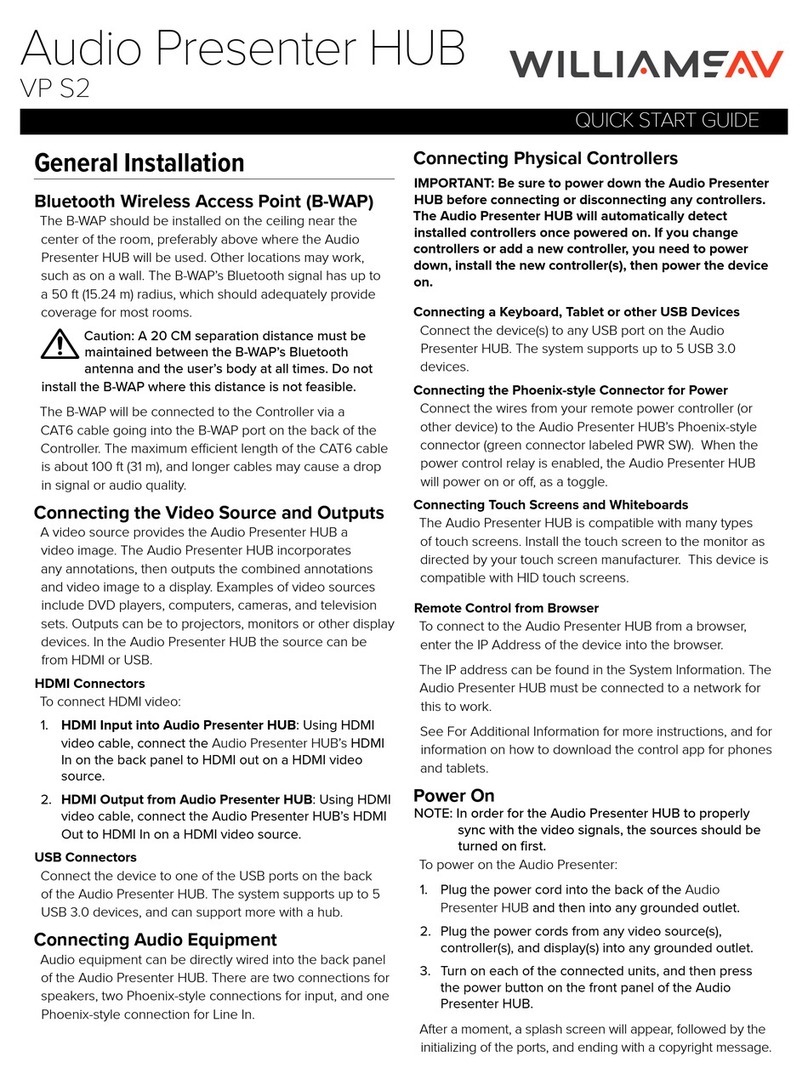
Presenter Hub
VP S1
QUICK START GUIDE
General Installation
Connecting the Video Source and Outputs
A video source provides the Presenter HUB a video image.
The Presenter HUB incorporates any annotations, then
outputs the combined annotations and video image to a
display. Examples of video sources include DVD players,
computers, cameras, and television sets. Outputs can be
to projectors, monitors or other display devices. In the
Presenter HUB, the source can be from HDMI or USB.
HDMI Connectors
To connect HDMI video:
1. HDMI Input into Presenter HUB: Using HDMI video
cable, connect the Presenter HUB’s HDMI In on the
back panel to HDMI out on a HDMI video source.
2. HDMI Output from Presenter HUB: Using HDMI video
cable, connect the Presenter HUB’s HDMI Out to HDMI
In on a HDMI video source.
USB Connectors
Connect the device to one of the USB ports on the back of
the Presenter HUB. The system supports up to 5 USB 3.0
devices, and can support more with a hub.
Connecting Physical Controllers
IMPORTANT: Be sure to power down the Presenter HUB
before connecting or disconnecting any controllers.
The Presenter HUB will automatically detect installed
controllers once powered on. If you change controllers or
add a new controller, you need to power down, install the
new controller(s), then power the device on.
Connecting a Keyboard, Tablet or other USB Devices
Connect the device(s) to any USB port on the Presenter
HUB. The system supports up to 5 USB 3.0 devices.
Connecting the Phoenix-style Connector for Power
Connect the wires from your remote power controller
(or other device) to the Presenter HUB’s Phoenix-style
connector (green connector labeled PWR SW). When the
power control relay is enabled, the Presenter HUB will
power on or o, as a toggle.
Connecting a Mouse Device via USB
Connect the mouse device to a USB port on the back of the
Presenter HUB.
Connecting Touch Screens and Whiteboards
The Presenter HUB is compatible with many types of touch
screens. Install the HID touch screen to the monitor as
directed by your touch screen manufacturer.
Remote Control from Browser
To connect to the Presenter HUB from a browser, enter the
IP Address of the Presenter HUB into the browser.
The IP address of the Presenter HUB can be found in the
System Information. The Presenter HUB must be connected
to a network for this to work.
See For Additional Information for more instructions, and for
information on how to download the control app for phones
and tablets.
Power On
NOTE: In order for the Presenter HUB to properly sync with
the video signals, the sources should be turned on
first.
To power on the Presenter HUB:
1. Plug the power cord into the back of the Presenter
HUB and then into any grounded outlet.
2. Plug the power cords from any video source(s),
controller(s), and display(s) into any grounded outlet.
3. Turn on each of the connected units, and then press
the power button on the front panel of the Presenter
HUB.
After a moment, the Presenter HUB splash screen will
appear, followed by the initializing of the ports, and ending
with a copyright message.
Basic Configuration
Main Menu Basics
The main menu is a large, hidden main menu system mostly
used for setup and configuration.
Use a keyboard to access this menu for initial
configuration. This menu will need to be accessed to get
your device connected to the network.
Activating the Menu
Keyboard: Press Setup Menu (Print Screen) key.
Touch Screen (or Whiteboard): Tap the upper center
function area.





















